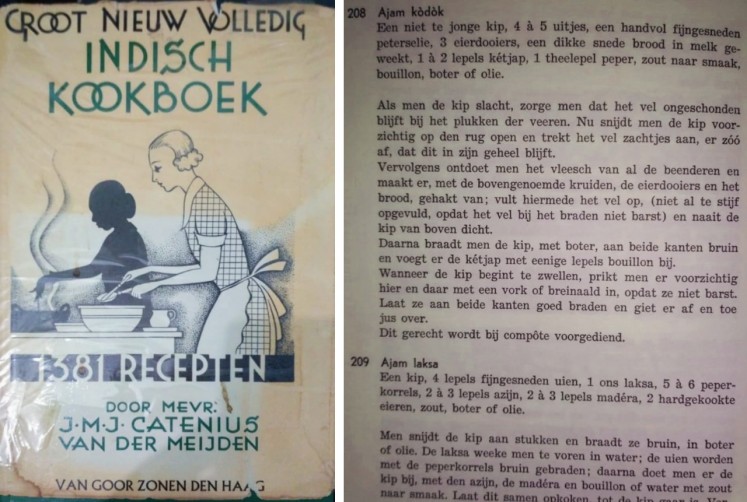Popular Reads
Top Results
Can't find what you're looking for?
View all search resultsPopular Reads
Top Results
Can't find what you're looking for?
View all search results'Ayam kodok': Indonesia’s near-forgotten holiday dish
For some Indonesians who celebrate Christmas, a staple of the holidays is ayam kodok, which literally translates to frog chicken. But there is actually no frog at all in the dish.
Change text size
Gift Premium Articles
to Anyone
F
or some Indonesians who celebrate Christmas, a staple of the holidays is ayam kodok, which literally translates to frog chicken. But there is actually no frog at all in the dish. It is in fact just a stuffed chicken, with minced chicken and sometimes beef or pork as fillings.
The origin of ayam kodok dates back to the colonial era, when Dutch cooks published Indonesian cookbooks that included recipes for gevulde kip (stuffed chicken).
The origin of the dish dates back to the colonial era, when Dutch cooks published Indonesian cookbooks with traditional recipes. (JP/File)Fadly Rahman, lecturer of Padjajaran University in Bandung and author of Jejak rasa Nusantara: Sejarah Makanan Indonesia (Archipelago Flavor Trail: The History of Indonesian Food), told The Jakarta Post in a telephone interview that ayam kodok was originally a Dutch creation using ingredients available in Indonesia, based on two French forcemeat dishes: ballotine and galantine.
“[…] the Dutch people introduced the dish [ayam kodok] not only for Christmas, but for other special occasions where fancy feasts are involved,” said Fadly, adding that the dish was special as it was big enough to be shared by 15 to 20 people.
Furthermore, ayam kodok is considered a fancy dish due to its complicated cooking process: First, most of the meat and bones are stripped from a chicken, leaving only its skin, wings and legs. The meat is then minced and mixed with other proteins and herbs and seasonings, then inserted back into the skin. Finally, the stuffed chicken is steamed and roasted.
Senior journalist and co-author of Indonesian Dishes and Desserts Hiang Marahimin – who likes to cook ayam kodok – described how the shape of the chicken widened and flattened after roasting as a result of the bones being removed.
“That is why the dish is called ayam kodok, because the chicken’s shape becomes similar to that of a frog,” said Hiang, explaining that the dish required a complicated cooking process.
To make ayam kodok, one can use a mature broiler chicken, according to Hiang, because a young chicken may have softer skin that tears easily during the process of deboning and stripping away meat. As the meat of a mature chicken is tough, mincing is a necessary step. Similarly, mincing chicken meat during the colonial era was standard, as there were only free-range chickens available that produced tough and lean meat.
Hiang explained that, in the past, the filling for ayam kodok needed additional meat from another chicken or other types of protein, including liver paste and pork.
“[…] boiled eggs could also be added to fill the hollow gaps in the chicken, in order to cut expenses to buy the meat,” said Hiang, adding that sometimes sausages were used instead of eggs.
Fadly said the eggs in the dish could have a symbolic meaning.
“In the context of food tradition and culture, the reason why there are always eggs, whether in tumpeng (cone-shaped rice) or ayam kodok, is because an egg is an embryo, [the earliest stage of] of life, symbolizing rebirth and the transformation to purity,” said Fadly.
Read also: Heartfelt stories are main dish in Netflix’s 'Street Food'
Even though ayam kodok is suitable for serving large groups, it has seen its popularity decline.
Hiang said people today had so many food options that ayam kodok often became overlooked. However, she still cooks ayam kodok for reunions with her old friends. Meanwhile, Fadly said it was the complicated cooking process that made ayam kodok less popular.
“I heard from a few friends, especially those of Chinese descent, […] that the tradition of making ayam kodok had ended in their grandmother’s or mother’s generation,” said Fadly.
He went on to say that the younger generations were more into simpler cooking, with dishes like ayam kodok only ordered from home or made by professional cooks.
Among those who offer made-to-order ayam kodok is Aryati, a home cook based in South Jakarta.
“I started to receive orders from friends in September 2017, and then I took it seriously,” Aryati told the Post in a WhatsApp message. She learned how to make ayam kodok from a neighbor and grew to like cooking the dish for her family.
Most orders for ayam kodok come to Aryati during the holiday season. Even though the popularity of the dish has declined, she herself regularly receives orders throughout the year for customers buying ayam kodok for birthday parties and other events.
“It is not popular because you can’t just walk into a restaurant and order ayam kodok to eat right at that moment. It is best eaten fresh from the oven, and it takes two to three hours to make,” said Aryati.
Read also: Chefs join hands to put Indonesian cuisine on world map
One of the few restaurants that does prepare ayam kodok is Sate Khas Senayan, though only on a seasonal basis, serving the dish from early December to early January.
Innez Junianthy from Sate Khas Senayan’s marketing communications division told the Post that it was not easy to find Christmas-themed traditional Indonesian dishes. Unlike Idul Fitri, which sees a variety of traditional dishes, like ketupat (rice dumpling), Indonesia’s Christmas culture leans more toward the West.
"[With that in mind], we looked for an item closest to Indonesian [culinary traditions], although it is more like Peranakan food," she said, adding that nobody in the restaurant remembered when Sate Khas Senayan first offered ayam kodok even though it was acknowledged that the restaurant’s recipe for it was created by its own product development team.












